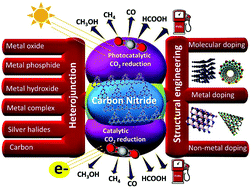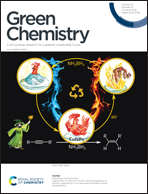Engineering graphitic carbon nitride (g-C3N4) for catalytic reduction of CO2 to fuels and chemicals: strategy and mechanism
Abstract
The reduction of carbon dioxide to useful fuels/chemicals, such as methane, formic, and methanol, is an innovative way to address looming energy and environmental issues. Graphitic carbon nitride (g-C3N4), as a greener and low-cost catalyst for the electrocatalytic and photocatalytic carbon dioxide reduction reaction (CO2RR) to provide usable fuels, is endowed with numerous appealing attributes, e.g., Earth-abundant resources, facile synthesis, metal-free nature, catalytic properties, and unique thermal-physical–chemical stability. Articles on the use of g-C3N4 for CO2 transformation have increased significantly in the past decade, and it is important to provide timely updates in this emerging and active research area. This review emphasizes the rational structural engineering of g-C3N4, including doping (i.e., metal, non-metal, and molecular) and heterojunction formation (i.e., metal, metal oxide, metal phosphide, metal hydroxide, metal complex, Ag-halides, and carbon materials) for electrocatalytic, photoelectrocatalytic, and photocatalytic CO2RR. Besides, an in-depth deciphering of the CO2RR mechanism from experimental, theoretical, and fundamental concepts is provided, including deliberation on the sources/emission and strategies to avoid/reduce CO2 emission. Lastly, a brief conclusion and outlook on the challenges and future prospects are highlighted to assist further in the rational design of the g-C3N4-based catalyst as a selective and efficient catalyst for the CO2RR.

- This article is part of the themed collection: Green Chemistry Reviews


 Please wait while we load your content...
Please wait while we load your content...